Experience the ultimate in cozy comfort food with our rich and flavorful Guinness Beef Stew. This hearty dish features succulent cubes of beef, tender carrots, and creamy potatoes simmered to perfection in a deeply savory, stout-infused gravy. Slow-cooked in a Dutch oven, it’s the ideal meal for chilly winter evenings or a delightful, warming alternative to traditional corned beef for your St. Patrick’s Day celebration. Prepare to impress your family and friends with a stew that’s both rustic and refined, promising a comforting taste in every spoonful.
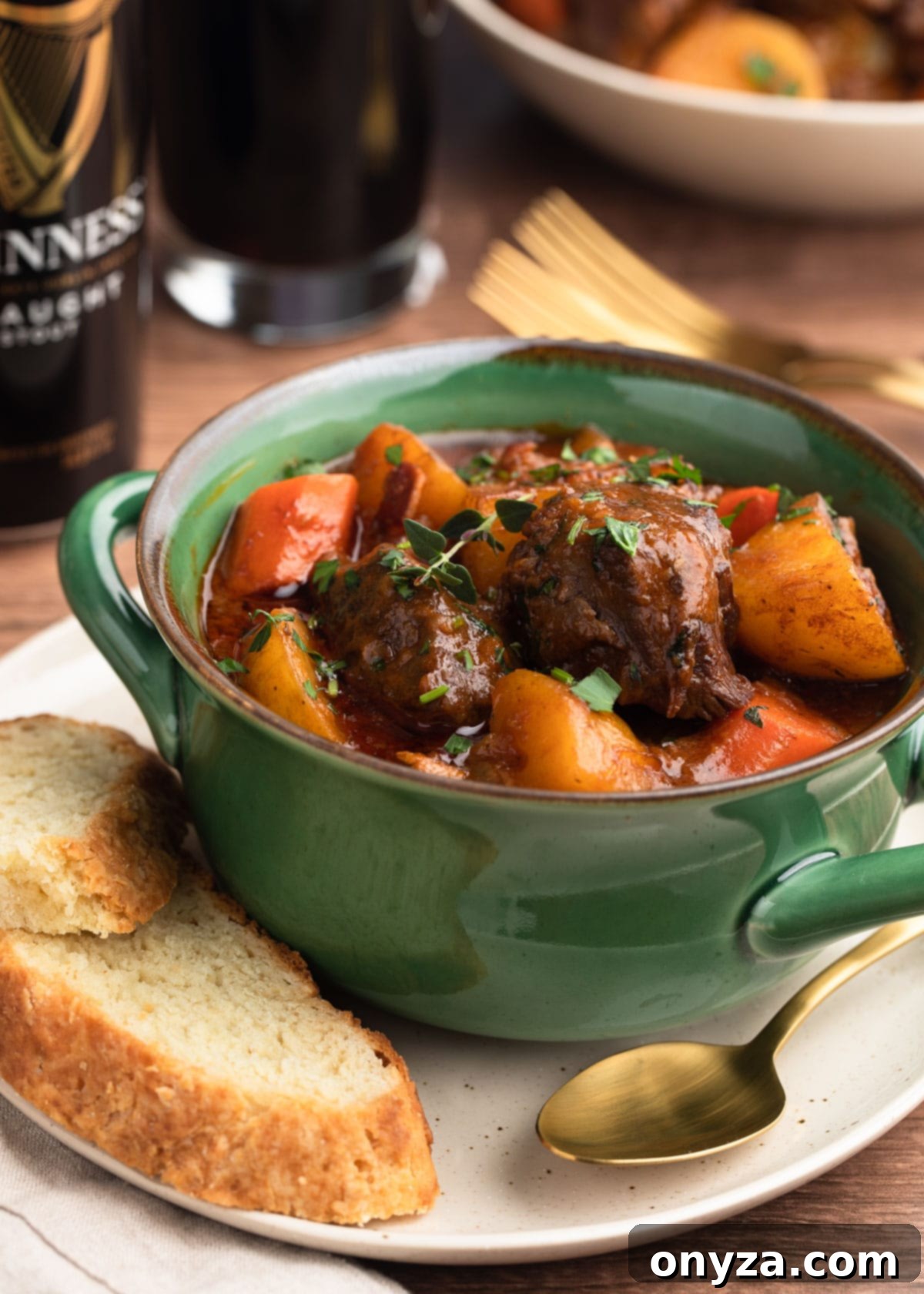
This post contains affiliate links. As an Amazon Associate, I earn a commission (at no additional cost to you) from qualifying purchases made by clicking these links. As always, all recommendations and opinions expressed are my own.
Guinness Beef Stew: A Culinary Journey into Irish-Inspired Comfort
There’s nothing quite like a steaming bowl of beef stew to banish the chill on a cold day. It’s a culinary hug, a dish that transcends cultures and brings families together around the dinner table. In our home, beef stew is a cherished classic, whether it’s the French sophistication of Beef Bourguignon, the familiar warmth of an All-American Beef Stew, or the rustic charm of Daube Provençal. Each version offers its unique appeal, but all share that quintessential cozy comfort food essence. Today, we delve into a particular favorite that combines rich beef with the iconic flavor of Ireland: Guinness Beef Stew.
The inspiration for this magnificent dish struck a few years ago in an unexpected place – the checkout line of a grocery store. A paperback cookbook titled Irish Pub Food (Publications International, 2019) caught my eye, specifically the tantalizing photo of Guinness Beef Stew on its cover. Intrigued, I flipped through the pages, finding myself captivated by the promise of deep, robust flavors. Since then, I’ve experimented with several interpretations, refining and adapting the concept. The recipe I’m thrilled to share with you today is a harmonious blend of that initial cookbook inspiration and my beloved Stout Braised Short Ribs recipe, resulting in a stew that is truly exceptional.
Note: While this Guinness Beef Stew is deeply inspired by Irish culinary traditions and uses a classic Irish stout, it is important to clarify that it is not an authentic Irish Stew, traditionally known as “Ballylamoe.” Authentic Irish Stew typically features lamb or mutton and relies on the slow cooking of root vegetables to naturally thicken its gravy, without the addition of flour. For those interested in exploring the fascinating history and evolution of true Irish Stew, I highly recommend reading Irish History in a Long-Simmered Stew from The Spruce Eats. Our version, however, celebrates the rich, malty notes of Guinness, creating a distinctively flavorful experience that pays homage to Irish spirit with a delightful twist.
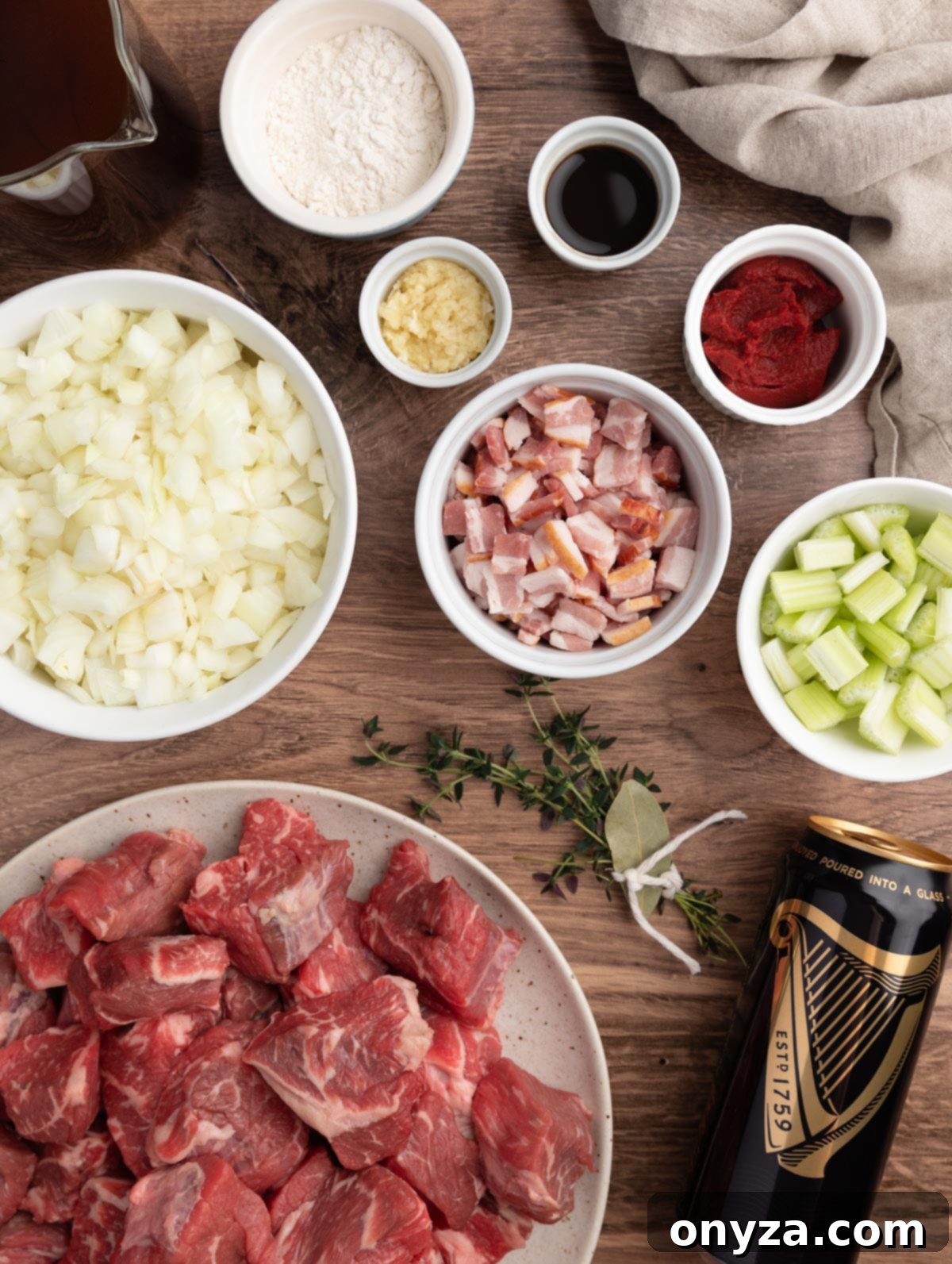
Essential Ingredients for an Unforgettable Guinness Beef Stew
Crafting a truly remarkable Guinness Beef Stew begins with selecting the right ingredients. Each component plays a vital role in building the layers of flavor and achieving that perfect comforting texture. Here’s a detailed look at what you’ll need:
- Boneless Beef Chuck Roast: This cut is the star of our stew. Opt for a well-marbled chuck roast, as the intramuscular fat will render slowly during cooking, contributing immense flavor and ensuring the beef cubes become meltingly tender. Cut the beef into generous 1-1/2 to 2-inch cubes. While you should trim off any excessive fat from the exterior, it’s crucial to leave the intramuscular fat intact within the meat for the best results.
- Bacon: A culinary secret weapon, bacon adds a depth of richness, a hint of saltiness, and a subtle smokiness that elevates the stew’s overall profile. Hickory-smoked bacon is my preferred choice for its robust flavor contribution.
- Vegetable Oil: Used for crisping the bacon and, crucially, for achieving a beautiful, flavorful brown crust on the beef cubes before slow simmering.
- Guinness Draught: This is the heart of our stew’s unique flavor. It’s essential to use the “Draught” version of Guinness, known for its creamy, smoother profile, rather than “Extra Stout.” The latter possesses more assertive bitter notes that can overpower the delicate balance of the reduced gravy, whereas the Draught contributes a pleasant malty depth without excessive bitterness.
- All-Purpose Flour: A key thickening agent. When incorporated early in the cooking process, the flour helps to create a rich, velvety gravy as the stew slowly reduces in the oven.
- Dark Brown Sugar: This ingredient is a clever addition, a tip I learned from Cooks Illustrated. It effectively balances and offsets any residual bitter notes from the stout, enhancing the stew’s savory characteristics with a subtle sweetness.
- Tomato Paste: A concentrated umami powerhouse, tomato paste provides a foundational layer of savory depth. It significantly boosts the beefy flavors of the stew and beautifully complements the rich, malty notes of the stout.
- Worcestershire Sauce: Another fantastic enhancer of umami, this savory sauce adds another complex layer of flavor, tying all the robust ingredients together.
- Beef Stock: The primary liquid base for our stew. While homemade beef stock offers unparalleled flavor, a good quality, low-sodium or unsalted store-bought variety works perfectly. Opting for low-sodium allows you to control the seasoning precisely.
- Fresh and Dried Herbs: Dried bay leaf and fresh thyme are essential for infusing the stew with aromatic depth as it cooks. Fresh parsley, stirred in just before serving, provides a vibrant burst of color and a fresh, herbaceous finish. For ease of removal, I often tie the thyme sprigs and bay leaf together into a bouquet garni.
- Aromatics: A classic trifecta of yellow onions, celery, and garlic forms the foundational aromatic base, sautéed to release their sweet and pungent flavors.
- Root Vegetables: Sweet carrots and buttery Yukon Gold potatoes are not just hearty accompaniments but also absorb the rich gravy beautifully. Cut both into approximately 1-inch pieces for even cooking. For carrots, slightly fatter ones tend to hold their shape better during slow cooking. Yukon Gold potatoes, with their thin skins, can be cooked peeled or unpeeled, according to your preference.
- Cornstarch Slurry: A simple mixture of equal parts cornstarch and beef stock, this slurry is a handy tool to adjust the gravy’s thickness at the end of cooking, ensuring it reaches your desired consistency.
Equipment Note: This recipe is designed to be cooked in a Dutch oven, an indispensable piece of cookware for slow-braised dishes. Its heavy construction ensures even heat distribution and retention, crucial for tenderizing the beef and developing rich flavors. For this stew, a 5-1/2 to 6-3/4 quart Dutch oven is ideal. Le Creuset’sRound Wide 6-3/4 Quart Dutch Oven is pictured here and is my absolute go-to for stews and braises of all kinds. Le Creuset’s5-1/2 Quart Round Dutch Oven is also an excellent choice, as is Staub’s 5-1/2 Quart Round Cocotte. Any similar heavy-bottomed, oven-safe pot with a tight-fitting lid will work beautifully.

Crafting Your Guinness Beef Stew: A Step-by-Step Guide to Perfection
While making this Guinness Beef Stew is a leisurely, all-afternoon affair, don’t let the cooking time intimidate you! The beauty of this recipe lies in its largely hands-off nature after the initial preparation. A little effort upfront is handsomely rewarded with an incredibly rich, complex gravy and beef so tender it practically melts in your mouth. This methodical approach allows flavors to meld and deepen over hours, transforming simple ingredients into an extraordinary culinary experience. Here’s how to master this hearty stew, broken down into six essential steps for clarity and success.
Building the Flavor Base: The Foundation of a Great Stew
The first crucial steps involve building a robust flavor foundation. This stage is where you layer in rich, savory notes that will define the character of your finished stew.
- Render the Bacon Fat to Begin: Start by dicing your bacon and cooking it in your Dutch oven over medium heat with a splash of vegetable oil. Cook until the bacon is perfectly crisp and golden. This not only yields delicious crispy bacon for garnish (or snacking!) but, more importantly, renders out its flavorful fat, which will be the base for browning your beef. Once crisp, remove the bacon with a slotted spoon, reserving it for later, and leave the precious rendered fat in the pot. This fat is packed with flavor and will contribute significantly to the stew’s depth.
- Achieve a Deep Sear on the Beef Cubes: Pat your beef cubes thoroughly dry with paper towels; moisture prevents browning. Season them generously with salt and freshly ground black pepper. Now, working in batches to avoid overcrowding, brown the beef cubes in the bacon drippings over medium-high heat. Aim for a deep, rich brown crust on at least two sides of each cube – but if time allows, browning all sides will develop even more profound flavor through the Maillard reaction. Crowding the pot will cause the beef to steam rather than sear, hindering the development of that crucial caramelized flavor. Don’t rush this step; it’s the first and most critical layer of flavor in your stew!
- Sauté and Caramelize the Aromatics: After you’ve removed all the browned beef from the pan, it’s time to build more flavor. Add your chopped onions and celery to the Dutch oven, cooking them until they soften and begin to turn golden. This process sweetens them and creates more “fond” (browned bits) on the bottom of the pan. Next, stir in the minced garlic, tomato paste, and all-purpose flour. Continue to cook this mixture for just a couple of minutes, stirring constantly. You’ll notice the tomato paste transforming from a bright red to a deeper, rustier color; this indicates it’s caramelizing and concentrating its inherent umami flavors, which will become a crucial part of the gravy.
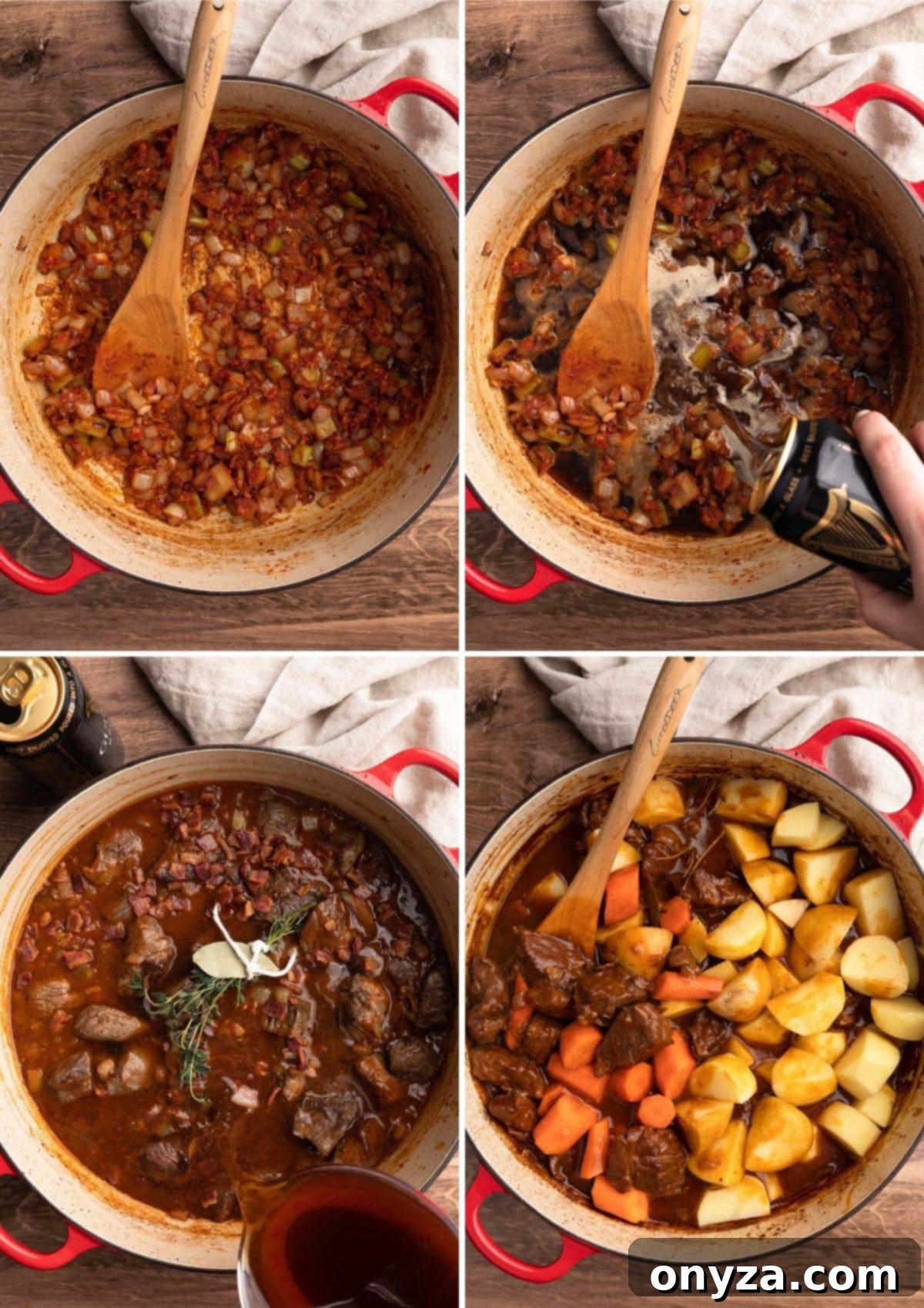
Cooking and Serving the Stew: Bringing it All Together
With the flavor base firmly established, the next steps involve combining all the ingredients and allowing the magic of slow cooking to transform them into a cohesive, delicious stew.
- Deglaze the Pan and Assemble the Stew: Pour the Guinness Draught directly into the hot Dutch oven. Immediately use a wooden spoon to vigorously scrape up all the “fond” – those rich, flavorful brown bits that have accumulated on the bottom and sides of the pot. This deglazing step incorporates all that concentrated flavor back into the liquid, forming the base of your gravy. Return the browned beef cubes and any juices they’ve released back into the pot. Stir in the reserved crispy bacon, beef stock, Worcestershire sauce, dark brown sugar, and your prepared bouquet garni. Ensure the beef is mostly submerged in liquid; add a little more stock if necessary.
- Slow Cook to Perfection in the Oven: Bring the stew to a gentle simmer on the stovetop. Once simmering, cover the Dutch oven tightly and carefully transfer it to your preheated 325°F oven. Let it cook for 1-1/2 hours, stirring halfway through to ensure even cooking. After this initial phase, add the chopped root vegetables (carrots and potatoes) to the Dutch oven. Give it another gentle stir, cover, and continue cooking for approximately another hour, or until the beef is lusciously fall-apart tender, and the vegetables are perfectly fork-tender but still hold their shape beautifully without becoming mushy. This slow oven cooking ensures even heat and prevents scorching, yielding a truly tender result.
- Final Touches: Skim, Thicken, Season, and Serve: Once the stew is cooked, remove it from the oven. Using a large spoon or ladle, carefully skim any excess fat that has risen to the surface of the gravy. Discard the bouquet garni, as it has now imparted all its flavor. At this point, assess the gravy’s consistency. If it’s not as thick as you prefer, create a cornstarch slurry by whisking together equal parts cornstarch and a small amount of beef stock. Gradually stir this slurry into the stew, a teaspoonful at a time, while simmering it gently on the stovetop until your desired gravy consistency is reached. Finally, gently stir in the fresh parsley for brightness and season the stew to taste with kosher salt and freshly ground black pepper. Serve immediately and enjoy the fruits of your labor!
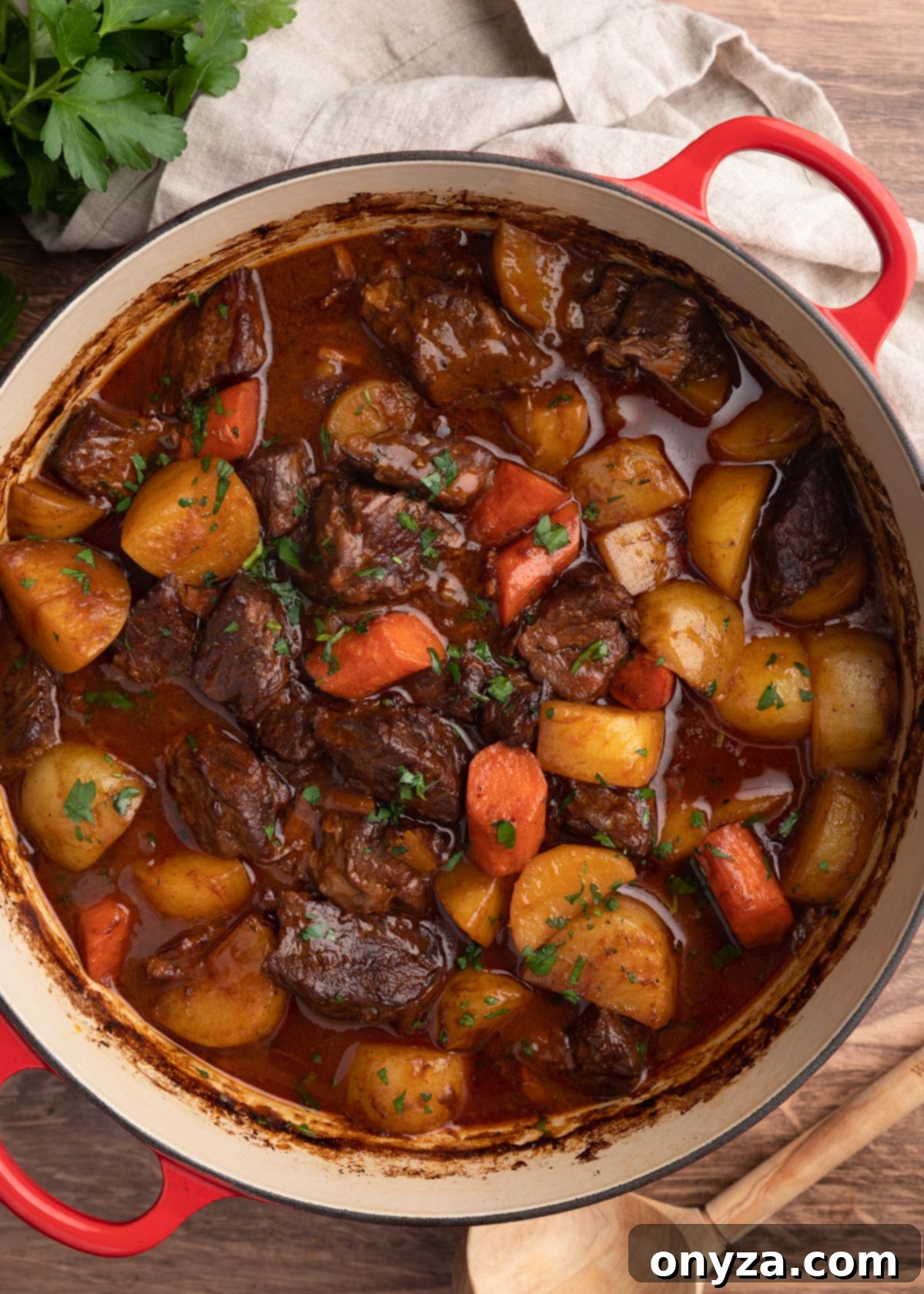
Serving, Storing, and Reheating Your Hearty Guinness Beef Stew
Once your Guinness Beef Stew is simmering to perfection, the anticipation builds for that first delicious bite. This stew is a complete meal in itself, but a few accompaniments can elevate the experience even further. We particularly love serving it in deep, comforting bowls, perfect for holding every drop of the rich gravy. A generous slice of homemade Irish-American Soda Bread on the side is an absolute must. I often bake a loaf with just caraway seeds or a plain version (without raisins) specifically for dipping into the luscious gravy, allowing it to soak up all those incredible flavors. It’s a simple pairing that truly enhances the rustic charm of the dish.
On a lighter note, a humorous debate often arises in my house during recipe photo shoots: should stew be eaten with a fork or a spoon? Our family is surprisingly divided on this matter! Personally, I’m firmly “Team Spoon” – it’s the best tool to ensure you capture every last bit of that savory, stout-infused gravy. What’s your preference? We’d love to hear your thoughts in the comments below!
Reheating Your Guinness Beef Stew for Encore Meals
While the texture of the root vegetables is truly at its peak on the first day, leftover stew is still incredibly delicious and makes for fantastic subsequent meals. You can safely store leftover Guinness Beef Stew, well-covered, in the refrigerator for up to 3-4 days. This makes it an excellent candidate for meal prep, allowing you to enjoy a gourmet dinner with minimal effort on busy weeknights.
When you’re ready to reheat, remove the stew from the refrigerator about 30 minutes beforehand to allow it to come closer to room temperature. You might notice a solidified layer of fat on the surface; use a spoon to skim this off before reheating. To warm the stew, you have a couple of options: gently heat it on the stovetop over medium-low heat, stirring occasionally. Be gentle as you stir to avoid breaking up the beautifully tender meat and root vegetables. Alternatively, for a more hands-off approach, you can pop the entire Dutch oven into a 350°F oven for approximately 45 minutes, or until thoroughly heated through.
As the stew heats, you might find that the potatoes have absorbed a good deal of the liquid, causing the gravy to thicken significantly. If needed, add a splash or two of additional beef stock to loosen the gravy and bring it back to your desired consistency. A little extra stock can revive the stew’s texture beautifully.
I do not recommend freezing this Guinness Beef Stew recipe. While many stews freeze well, the starchy nature of the potatoes means their texture will degrade significantly upon thawing and reheating, often becoming grainy or mushy. Furthermore, the flour and cornstarch used to thicken the gravy can sometimes separate in the freezer, resulting in an unappealing texture. For the best culinary experience, enjoy this stew fresh or refrigerated.
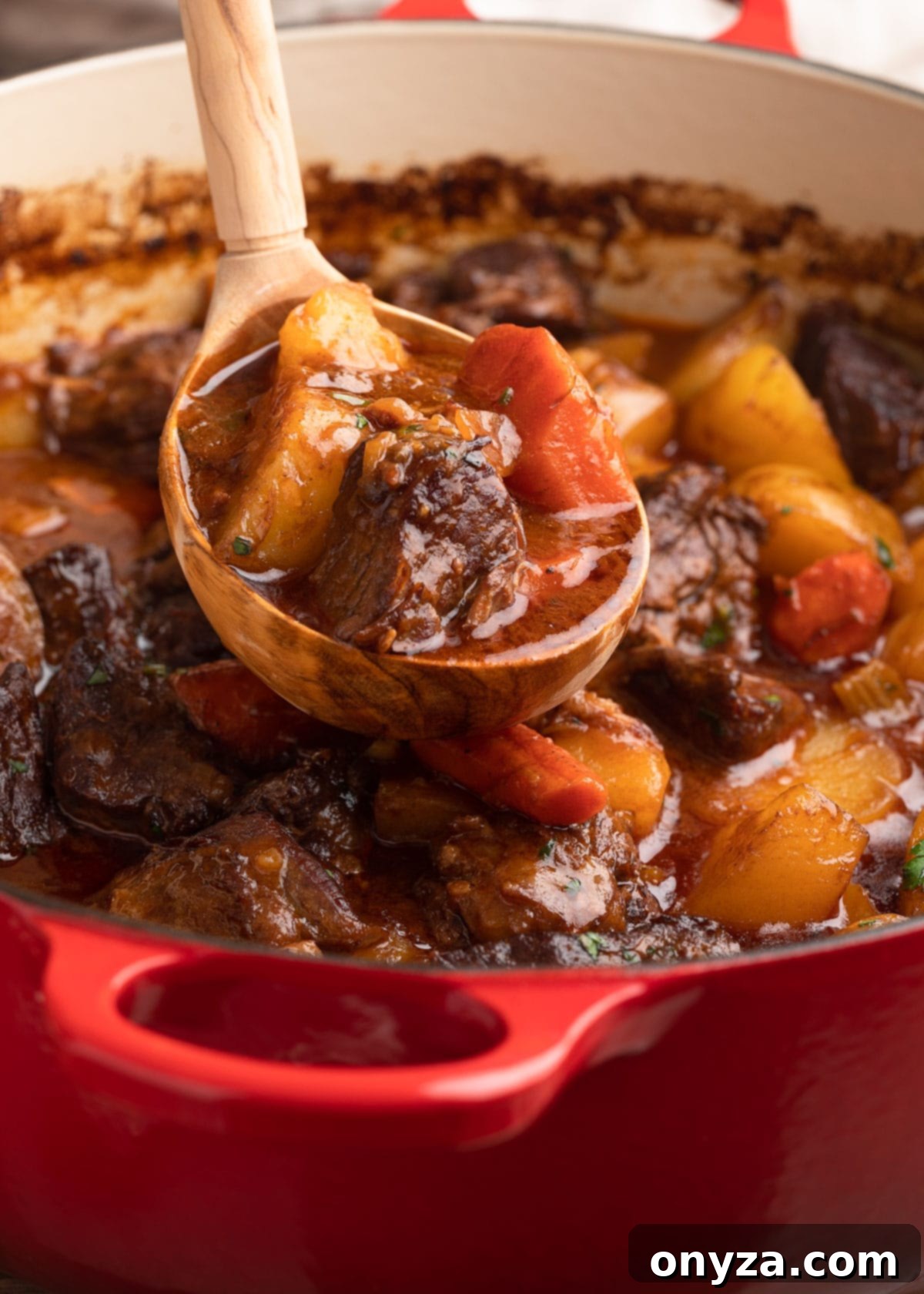
Guinness Beef Stew: Frequently Asked Questions (FAQs)
Here are some common questions about making and customizing your Guinness Beef Stew, along with helpful answers to ensure your cooking experience is seamless and delicious.
Q. I can’t find Guinness Draught locally. Can I use another stout?
A. While Guinness Draught is quite widely distributed and often the easiest to find in the United States, if your local grocery store or liquor shop doesn’t carry it, don’t despair! Murphy’s Irish Stout is an excellent and highly recommended alternative. Murphy’s is typically creamier and notably less bitter than both Guinness Draught and Extra Stout. With its pleasant coffee and chocolate undertones, it’s a fantastic choice if you prefer to dial down any bitter notes in your gravy. When using Murphy’s in this stew, I often find that I don’t need to add the dark brown sugar, as its inherent sweetness provides enough balance.
If you’re fortunate enough to have access to a good craft beer selection, I also highly recommend Atlantic Brewing Company’s Cadillac Mountain Stout. This dry, Irish-style stout is truly fantastic in both braised and stewed dishes, and it’s equally delightful for sipping on its own!
Q. Can I use other root vegetables in my stew?
A. Absolutely! This recipe is quite versatile, and you can certainly experiment with other root vegetables to tailor the stew to your taste. The original Irish Pub Food cookbook that inspired this recipe, for instance, included turnips alongside the potatoes and carrots. Turnips add a lovely, subtle sweetness to the stew and hold up well to long cooking times.
You could also consider substituting parsnips for some of the potatoes, as parsnips are a popular ingredient in traditional Irish cooking. However, I advise using a light hand with parsnips. Their flavor profile is distinctly spicier and can have a slight licorice-like note, which might become a little too assertive and potentially clash with the robust flavor of the stout if used in large quantities. No matter which root vegetables you choose, make sure to cut them into uniform 1-inch cubes. This ensures they cook evenly and become tender at the same rate. Add them to the Dutch oven during the last hour of cooking, as specified for the carrots and potatoes, to prevent them from becoming overly soft or mushy.
Q. Can I make Guinness Beef Stew in a Crockpot or Instant Pot?
A. As of the initial publication of this recipe, I have specifically developed and tested it for cooking in a Dutch oven within a conventional oven. I have not yet thoroughly tested this particular recipe in alternate cooking methods such as a slow cooker (Crockpot) or an electric pressure cooker (Instant Pot). While many beef stew recipes can be adapted for these appliances, precise cooking times and potential adjustments to ingredient quantities (especially liquids) would be necessary to achieve the same rich flavor and tender texture. I plan to test these alternative cooking methods in the future. When I have fully evaluated and can definitively advise on appropriate cooking times and any required changes to the ingredient list, I will update this post and the recipe card accordingly.
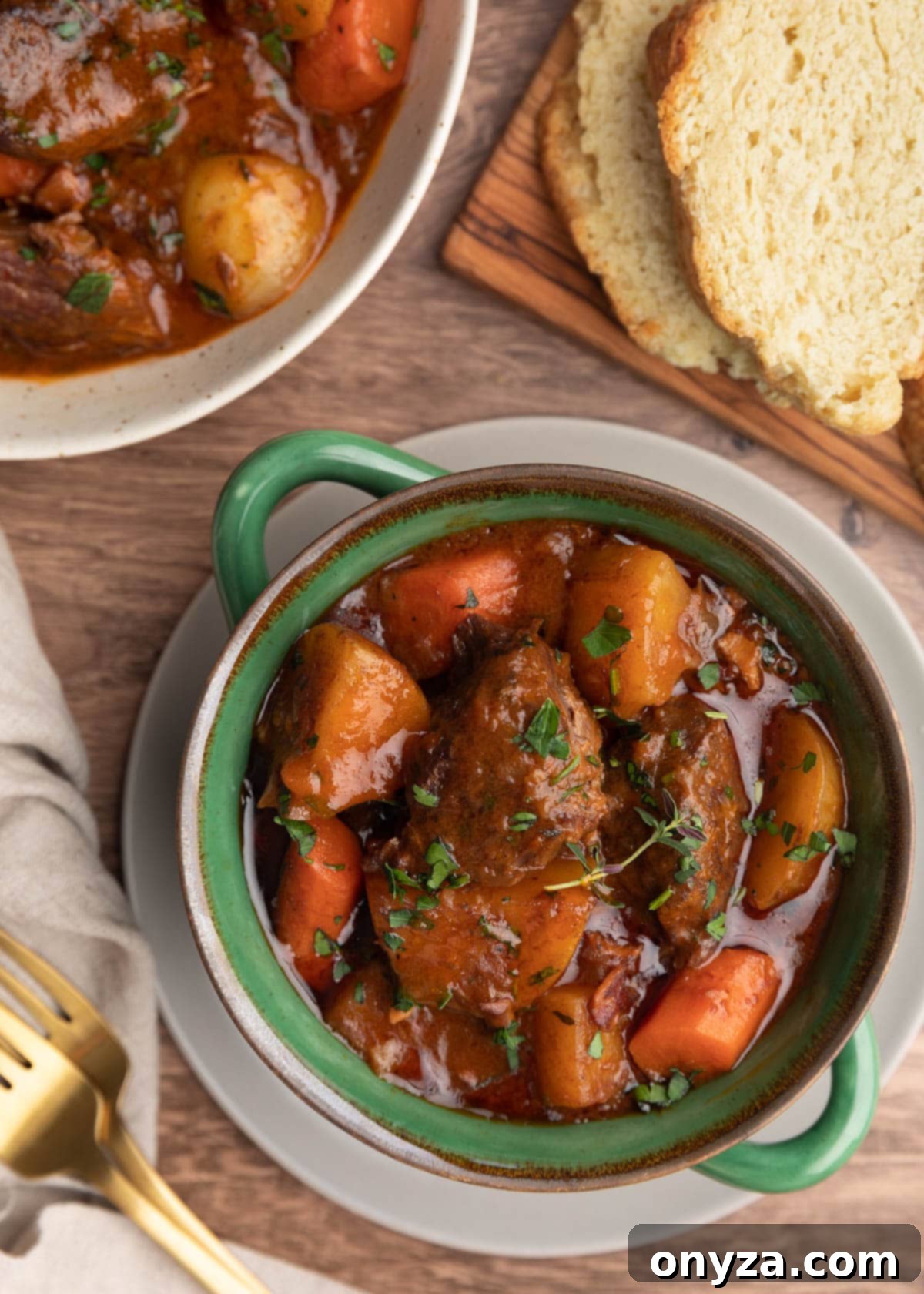
More Festive Recipes for Your St. Patrick’s Day Celebration
If you’re looking for more delicious dishes to celebrate St. Patrick’s Day or simply enjoy comforting Irish-inspired cuisine, explore these fantastic recipes:
- Classic Corned Beef Dinners: Discover various ways to prepare this festive favorite with Beer Braised Corned Beef with Whiskey-Mustard Glaze, Instant Pot Corned Beef and Cabbage, and Slow Cooker Corned Beef and Cabbage.
- Roasted Cabbage Wedges: A simple yet flavorful side dish that perfectly complements any main course.
- Stout-Braised Short Rib Cottage Pie: A luxurious twist on a traditional comfort food, rich with stout and tender short ribs.
- Colcannon: A creamy, delicious Irish mashed potato dish with cabbage or kale, perfect for any meal.
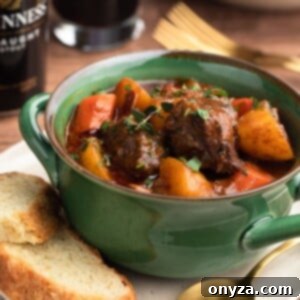
Guinness Beef Stew
Equipment
- Large Dutch oven (5-1/2 to 6-3/4 quarts)
Ingredients
- 3 pound well-marbled boneless beef chuck roast
- 1 tablespoon vegetable oil
- 4 ounces bacon, diced
- 2 medium onions, chopped (2 to 2-1/2 cups)
- 2 large celery stalks, cut into 1/2-inch dice (about 3/4 cup)
- 3-4 large garlic cloves, minced (1 tablespoon)
- 3 tablespoons tomato paste
- ¼ cup all purpose flour
- 1-1/2 tablespoons dark brown sugar, packed
- 1 tablespoon Worcestershire sauce
- 12 ounces Guinness Draught (not “Extra Stout”)
- 5 sprigs fresh thyme
- 1 large dried bay leaf
- 3 to 4 cups low sodium or unsalted beef stock, as needed
- 4-5 large carrots (about 1 pound), peeled and cut into 1-inch pieces
- 1-1/2 pounds Yukon gold potatoes, peeled or unpeeled (your choice), cut into 1-inch pieces
- ¼ cup chopped flat-leaf parsley
- 2 tablespoons cornstarch (if needed to make a slurry)
- kosher salt and freshly ground black pepper
Instructions
Prep the Beef
- Preheat the oven to 325 degrees F with the rack in the lower middle position. Tie the thyme sprigs and bay leaf together into a bundle (a bouquet garni) with kitchen twine and set aside.
- Trim the chuck roast of excess fat on the sides and cut the meat into 1-1/2 to 2-inch cubes. Dry the cubes well with paper towels and season generously with salt and pepper just before searing.
Saute and Sear
- Heat the vegetable oil over medium heat in a large Dutch oven (5-1/2 to 6-3/4 quarts). Add the bacon and cook until crisp. Remove the bacon with a slotted spoon to a paper towel lined plate to drain. Leave the rendered bacon fat and oil in the pan.
- Sear the beef cubes in the Dutch oven in batches over medium-high heat until well browned. (Brown the beef on at least two sides, or on all sides for additional flavor.) Be mindful not to overcrowd the pan so that the meat browns without steaming. Remove beef cubes to a clean plate and set aside.
- Add onions and celery to the Dutch oven with a pinch or two of salt and pepper. Cook for 5-8 minutes, until softened and beginning to brown. Stir in garlic, tomato paste, and flour. Continue to cook over medium heat for about 2 minutes, stirring, until the tomato paste develops a rich rust color. (Watch it carefully so it doesn’t burn.)
Assemble the Stew
- Deglaze the pan with the stout, scraping the fond (the brown bits) from the bottom and sides of the Dutch oven for 1-2 minutes.
- Add the beef cubes back into the pot with any accumulated juices. Stir in the reserved bacon, 3 cups of beef stock (to cover the beef cubes; add additional, if needed, depending on the dimensions of your pot), Worcestershire sauce, brown sugar, and the bouquet garni.
Cook the Stew
- Bring the stew to a boil on the stove. Cover the Dutch oven and transfer it to the oven. Cook for 90 minutes, stirring halfway through.
- Stir the potatoes and carrots into the stew. (Check the liquid level at this point. If it’s reduced significantly and looks dry once the root vegetables are added, stir in a little more stock.) Cover and continue cooking for 60-80 minutes, until the beef is fall apart tender and the potatoes and carrots are fork tender.
Thicken the Stew (If Needed) and Serve
- Remove the stew from the oven and use a spoon to skim fat from the surface of the gravy. (There might be a significant amount, depending on the marbling in the beef.) Discard the bouquet garni.
- The defatted gravy might need thickening, based on how much stock you used, and your personal preferences. Whisk together 2 tablespoons cornstarch with 2 tablespoons of room temperature beef stock in a small bowl (a “slurry”). Gently stir the slurry into the stew by the teaspoonful as you bring the stew back to a boil on the stove, until your desired gravy consistency is reached.
- Stir in the parsley and season the stew to taste with salt and pepper. (The amount of salt will depend on the sodium content of your stock.)
- Serve Guinness Beef Stew hot in deep bowls with Irish Soda Bread on the side to dip into the gravy.
Notes
Leftover stew can be stored in the refrigerator for 3-4 days. See the Reheating the Stew section of the attached article for leftover/reheating instructions.
Nutrition Estimate
Nutrition information is automatically calculated, so should only be used as an approximation.
Please note that our recipes have been developed using the US Customary measurement system and have not been tested for high altitude/elevation cooking and baking.
Want to see a quick visual guide to this delicious recipe? Check out our Guinness Beef Stew Web Story.
